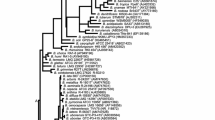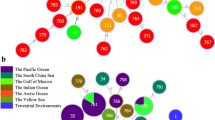Abstract
Genetic relationships and diversity of 101 Thermus isolates from different geothermal regions in Iceland were investigated by using multilocus enzyme electrophoresis (MLEE) and small subunit ribosomal rRNA (SSU rRNA) sequence analysis. Ten polymorphic enzymes were used and seven distinct and genetically highly divergent lineages of Thermus were observed. Six of seven lineages could be assigned to species whose names have been validated. The most diverse lineage was Thermus scotoductus. In contrast to the other lineages, this lineage was divided into very distinct genetic sublineages that may represent subspecies with different habitat preferences. The least diverse lineage was Thermus brockianus. Phenotypic and physiological analysis was carried out on a subset of the isolates. No relationship was found between growth on specific single carbon source to the grouping obtained by the isoenzyme analysis. The response to various salts was distinguishing in a few cases. No relationship was found between temperature at the isolation site and the different lineages, but pH indicated a relation to specific lineages.



Similar content being viewed by others
References
Amann RI, Ludwig W, Schleifer KH (1995) Phylogenetic identification and in situ detection of individual microbial cells without cultivation. Microbial Rev 59:143–169
Balkwill DL, Kieft TL, Tsukuda T, Kostandarithes HM, Onstott TC, Macnaughton S, Bownas J, Fredrickson JK (2004) Identification of iron-reducing Thermus strains as Thermus scotoductus. Extremophiles 8:37–44
Brock TD, Freeze H (1969) Thermus aquaticus gen. n. and sp. n., a nonsporulating extreme thermophile. J Bacteriol 98:289–297
Cashion P, Holder-Franklin MA, McCully J, Franklin M (1977) A rapid method for the base ratio determination of bacterial DNA. Anal Biochem 81:461–466
Caugant DA, Mocca LF, Frasch CE, Froholm LO, Zollinger WD, Selander RK (1987) Genetic structure of Neisseria meningitidis populations in relation to serogroup, serotype, and outer membrane protein pattern. J Bacteriol 169:2781–2792
Chung AP, Rainey FA, Valente M, Nobre MF, da Costa MS (2000) Thermus igniterrae sp. nov. and Thermus antranikianii sp. nov., two new species from Iceland. Int J Syst Evol Microbiol 50:209–217
Escara JF, Hutton JR (1980) Thermal stability and renaturation of DNA in dimethylsulphoxide solutions: acceleration of the renaturation rate. Biopolymers 19:1315–1327
Goodfellow M, O’Donnell AG (1993) Roots of bacterial systematics. In: Goodfellow M, O’Donnell AG (eds) Handbook of new bacterial systematics. Academic, London, pp 3–54
Hjorleifsdottir S, Skirnisdottir S, Hreggvidsson GO, Holst O, Kristjansson JK (2001) Species composition of cultivated and non-cultivated bacteria from short filaments in an Icelandic hot spring at 88°C. Microbial Ecol 42:117–125
Hudson JA, Morgan HW, Daniel RM (1987) Thermus filiformis sp. nov., a filamentous caldoactive bacterium. Int J Syst Bacteriol 37:431–436
Huss VAR, Festl H, Schleifer KH (1983) Studies on the spectrometric determination of DNA hybridization from renaturation rates. J Syst Appl Microbiol 4:184–192
Jukes TH, Cantor CR (1969) Evolution of protein molecules. In: Muntu HN (ed) Mammalian protein metabolism, 3rd edn. Academic Press, New York, pp 21–132
Kristjansson JK, Hreggvidsson GO (1995) Ecology and habitats of extremophiles. World J Microbiol Biotechnol 11:17–25
Kristjansson JK, Hreggvidsson GO, Grant WD (2000) Taxonomy of extremophiles. In: Priest FG, Goodfellow M (eds) Applied microbial systematics. Kluwer Academic, Dordrecht, pp 229–289
Kristjansson JK, Hjorleifsdottir S, Marteinsson VT, Alfredsson GA (1994) Thermus scotoductus sp. nov., a pigment-producing thermophilic bacterium from hot tap water in Iceland and including Thermus sp. X-1. Syst Appl Microbiol 17:44–50
de Ley J, Cattoir H, Reynaerts A (1970) The quantitative measurement of DNA hybridization from renaturation rates. Eur J Biochem 12:133–142
Madigan MT, Parker J, Brock TD, Martinko JM (1997) Brock biology of microorganisms, 8th edn. Prentice-Hall, Upper Saddle River
Maidak BL, Cole JR, Parker Jr CT, Garrity GM, Larsen N, Li B, Lilburn TG, McCaughey MJ, Olsen GJ, Overbeek R, Pramanik S, Schmidt TM, Tiedje JM, Woese CR (1999) A new version of the RDP (Ribosomal Database Project). Nucleic Acids Res 27:171–173
Manchenko GP (1994) Handbook of detection of enzymes on electrophoretic gels. CRC Press, Boca Raton
Nei M, Chesser RK (1983) Estimation of fixation indices and gene diversities. Ann Hum Genet 47:253–259
Oshima T, Imahori K (1974) Description of Thermus thermophilus (Yoshida and Oshima) comb. nov., a nonsporulating thermophilic bacterium from a Japanese thermal spa. Int J Syst Bacteriol 24:102–112
Petursdottir SK, Kristjansson JK (1996) The relationship between physical and chemical conditions and low microbial diversity in the Blue Lagoon geothermal lake in Iceland. FEMS Microbiol Ecol 19:39–45
Petursdottir SK, Hreggvidsson GO, da Costa MS, Kristjansson JK (2000) Genetic diversity analysis of Rhodothermus reflects geographical origin of the isolates. Extremophiles 4:267–274
Selander RK, Caugant DA, Ochman H, Musser JM, Gilmour MN, Whittam TS (1986) Methods of multilocus enzyme electrophoresis for bacterial population genetics and systematics. Appl Environ Microbiol 51:873–884
Skirnisdottir S, Hreggvidsson GO, Holst O, Kristjansson JK (2001) Isolation and characterization of a mixotrophic sulfur-oxidizing Thermus scotoductus. Extremophiles 5:45–51
Smibert RM, Krieg NR (1994) Phenotypic characterization. In: Gerhardt P, Murray RGE, Wood WA, Krieg NR (eds) Methods for general and molecular bacteriology. American Society for Microbiology, Washington, pp 607–654
Spanevello MD (2001) The phylogeny of prokaryotes associated with Australia’s Great Basin. PhD thesis. Griffith University
Spanevello MD, Patel BKC (2004) The phylogenetic diversity of Thermus and Meiothermus from microbial mats of an Australian subsurface aquifer runoff channel. FEMS Microbiol Ecol 50:63–73
Stackebrandt E, Goebel BM (1994) Taxonomic note: a place for DNA–DNA reassociation and 16S rRNA sequence analysis in the present species definition in bacteriology. Int J Syst Bacteriol 44:846–849
Tabatabai MA (1974) A rapid method for determination of sulfate in water samples. Environ Lett 7:237–243
Vandamme P, Pot B, Gillis M, de Vos P, Kersters K, Swings J (1996) Polyphasic taxonomy, a consensus approach to bacterial systematics. Microbiol Rev 60:407–438
Whittam TS (1995) Genetic population structure and pathogenicity in enteric bacteria. In: Baumberg S, Young JPW, Wellington EMH, Saunders JR (eds) Population genetics of bacteria. Society for General Microbiology, Symposium 52. Cambridge University Press, Cambridge, pp 217 – 245
Whittam TS, Ochman H, Selander RK (1983) Multilocus genetic structure in natural populations of Escherichia coli. Proc Natl Acad Sci USA 80:1751–1755
Williams R, Sharp R (1995) The taxonomy and identification of Thermus. In: Sharp R, Williams R (eds) Thermus species. Plenum, New York, pp 1–42
Williams RAD, Smith KE, Welch SG, Micallef J, Sharp RJ (1995) DNA relatedness of Thermus strains, description of Thermus brockianus sp. nov., and proposal to reestablish Thermus thermophilus (Oshima and Imahori). Int J Syst Bacteriol 45:495–499
Williams RAD, Smith KE, Welch SG, Micallef J (1996) Thermus oshimai sp. nov., isolated from hot springs in Portugal, Iceland, and the Azores, and comment on the concept of a limited geographical distribution of Thermus species. Int J Syst Bacteriol 46:403–408
Author information
Authors and Affiliations
Corresponding author
Additional information
Communicated by G. Antranikian
Rights and permissions
About this article
Cite this article
Hreggvidsson, G.O., Skirnisdottir, S., Smit, B. et al. Polyphasic analysis of Thermus isolates from geothermal areas in Iceland. Extremophiles 10, 563–575 (2006). https://doi.org/10.1007/s00792-006-0530-3
Received:
Accepted:
Published:
Issue Date:
DOI: https://doi.org/10.1007/s00792-006-0530-3




